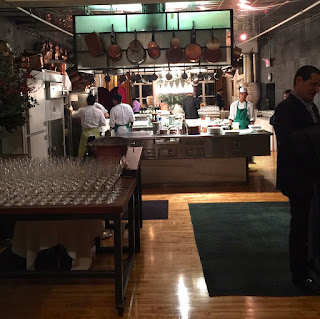 |
| The kitchen at Bouley Test kitchen |
In his opening remarks, Antonio Galloni spoke to the genesis of the tasting. Five years ago he had organized a Masseto vertical which went up to the 1986 vintage, the earliest in the label's history. It had been relatively easy to get Axel to lead that event. Not so this tasting. Antonio had to work overtime to convince Axel to do this dinner because the estate does not like to show the two wines in opposition to each other. In his opening remarks, Axel validated Antonio's comment about showing the wines together. The estate views the labels as two separate and distinct wines and treats them as such.
 |
| Axel Heinz speaking to some of the attendees prior to the start of the tasting |
As it relates to Masseto, Axel sees the wine as almost an accident of nature. When Ornellaia began, a few estates in Tuscany had already planted Merlot. Ornellaia felt that it had to do something to differentiate itself from the 400-lb gorilla in the room (Sassicaia) and that imperative drove the development of Masseto.
The early efforts in this direction were spearheaded by Andre Tschelistcheff, the noted Russian-American enologist, who found the hill with the grey clay and encouraged the Ornellaia team to plant Merlot thereon. The first harvest was in 1986 and the resultant wine was labeled Merlot. The name Masseto appeared on the label for the first time with the 1987 vintage.
With the success of Masseto, the estate did not want to use the Merlot grapes from that vineyard in the Ornellaia blend. It was a full 10 years before Merlot vines planted in other parts of the property attained the maturity to warrant their inclusion in the blend.
Axel sees the Masseto vineyard as very complex (I have assessed the vineyard in a previous post), a complexity akin to Burgundy's Clos Vougeot in that it has three levels and the soils are heterogeneous. In some vintages, they end up with as much as eight separate wines which have to be combined into the final blend (The estate harvests, vinifies, and ages individual plots separately and deploys a team to compose the final blend prior to bottling.).
Approximately 100 ha of vineyards are dedicated to grapes for the Ornellaia blend with different soils, elevations, and expositions being the order of the day. Ornellaia is more of a left-bank wine and Masseto more right bank (if one thinks in terms of Bordeaux) and Axel feels blessed in that being in Bolgheri gives him a chance to employ both winemaking styles in the same location.
I sat next to Axel during the course of the dinner and took advantage to gain his perspective on a number of winemaking issues. One area of exploration was optimal picking time. He was adamant that you need to taste the grapes in order to make a determination as to the best time to pick. In his view, no amount of data can substitute for the taste of the juice on your palate and the crunch (or not) of the seeds between your teeth. At Ornellaia they like to pick ripe with excellent aromatics without pressing through into over-ripeness.
He talked about the difficulty of working the clay soils of the Masseto vineyards. In periods of rain, the soil absobs the water and becomes very heavy. After it has become saturated, pooling becomes a problem. When the soils become water-logged, they have to leave it alone for a few days before returning to work at it again.
I asked him about the potential for a cru Masseto wine; that is, a wine drawn exclusively from one of the three areas of the Masseto vineyard. He saw that as very unlikely. Even though there are, from time to time, temptations regarding some of the components from the middle vineyard, it is the balance that these three vineyards bring in the bottle that is the essence of Masseto. He indicated that many people have told them that they should make a Cab Franc wine but they feel that Ornellaia would be hurt if they went down that path.
In closing this part of my discussion of the tasting, it should be mentioned that the estate is currently building a separate winery to support the production of Masseto. This is the ultimate gesture in showing the world that these are two truly distinct wines. While the field operations will still be conducted by a single team, the two winery operations will be separate. According to Axel, if you make a visit request to Masseto, you will go to the Masseto winery and taste Masseto wines; and likewise for an Ornellaia visit.
I will go into the details of the tasting and dinner in my next post.
©Wine -- Mise en abyme





No comments:
Post a Comment